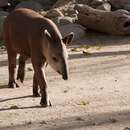en
names in breadcrumbs


The genus Tapirus is the sole genus in the family Tapiridae. The Tapiridae (tapirs), Equidae (horses), and Rhinocerotidae (rhinoceroses) together make up the order Perissodactyla (the odd-toed ungulates).
The genus Tapirus includes four species:
1. Lowland Tapir (Tapirus terrestris), with a geographic range encompassing much of approximately the northern half of South America. This is the only ungulate (hoofed mammal) that regularly disperses seeds in the Amazon, spitting them out or defecating them. Lowland Tapir home ranges are estimated to be between 2.5 and 5 square km.
2. Central American Tapir (Tapirus bairdii, sometimes placed in a separate genus, Tapirella), with a geographic range from southeastern Mexico to northwestern Colombia (and, at least formerly, western Ecuador west to the Gulf of Guayaquil). At 250 to 350 kg, this is the largest of the three New World tapirs, but the mean home range size for this species has been estimated to be only 1.25 square km.
3. Mountain Tapir (Tapirus pinchaque), found in the Andean areas of Colombia, Ecuador, and northern Peru and formerly in western Venezuela. This is the smallest of the tapirs and the only one covered with thick fur (explaining the alternate common name "Wooly Tapir"). The mean home range size for the Mountain Tapir has been estimated to be around 2.5 square km.
4. Malayan Tapir (Tapirus indicus, sometimes placed in a separate genus, Acrocordia), found in peninsular Malaysia, Thailand, and Burma as well as in southern and central Sumatra in the Indonesian Archipelago. This is the largest of the tapir species, weighing in between 280 and 400 kg. Although they prefer undisturbed primary forest, Malayan Tapirs have been recorded within 5 km of major cities in peninsular Malaysia. They are sometimes found in rubber plantations, where they may be regarded as pests for stripping the bark off rubber trees. Malayan Tapirs have home ranges of more than 10 square km.
Prehistoric tapirs inhabited Southeast Asia, Europe, and North America. With the formation of the Isthmus of Panama during the Pliocene (7 to 2 million years ago), tapirs moved south to Central and South America.
Female tapirs are generally larger than males. Tapirs are typically around 3 to 7 kg at birth. Young of all tapir species are dark with yellow or white stripes and spots. These begin to fade around three months and are virtually or completely gone at five to six months.
The proboscis of the tapir is derived from the snout and upper lip. It consists almost entirely of connective tissue and muscle, lacking the bone or cartilage found in the snouts of most mammals.
Tapirs have poor eyesight but good hearing and an acute sense of smell. They are generally closely associated with riparian forests, marshes, lakes, and streams. Tapirs are exclusively herbivorous. Although they are mainly browsers, they eat fruit readily when it is available. For at least some tapir species, palm forests provide a critical food resource (in the form of palm fruits).
Tapirs are mainly nocturnal and crepuscular, spending the hot days in the shade of dense vegetation. They can move quickly on land, even through thick underbrush, but are also excellent swimmers.Their main predators are Jaguars (Panthera onca) and Pumas (Puma concolor) in Central and South America and tigers (Panthera tigris) in Southeast Asia.
Tapir population densities tend to be low. Estimates have ranged from 0.3 per square km to 1.6 per square km. Tapirs are primarily solitary, usually traveling and feeding alone, with the exception of a mother and her young or a courting pair. The tapir calf stays with its mother for 12 to 18 months.
All four tapir species are known to raid crops and this often leads to their deaths at the hands of farmers. They are also hunted for sport and for meat, as well as for their skins –and their feet, for traditional medicinal uses. Cattle ranching drives away tapirs and may expose them to new infectious diseases. All but the Lowland Tapir are currently considered endangered and the Lowland Tapir is certainly endangered over parts of its range.
(Medici 2011 and references therein)
Tapirus is a genus of tapir which contains the living tapir species. The Malayan tapir is usually included in Tapirus as well, although some authorities have moved it into its own genus, Acrocodia.[2]
The Kabomani tapir was at one point recognized as another living member of the genus, but is now considered to be nested within T. terrestris.[4][5]
Tapirus first appeared in the Late Miocene in North America, with Tapirus webbi perhaps the oldest known fossil species.
Tapirus spread into South America and Eurasia during the Pliocene. It has been suggested that the tapirs that inhabited North America during the Late Pleistocene may be derived from a South American species that remigrated north, perhaps Tapirus cristatellus.[6]
Tapirs suffered large-scale extinctions at the end of the Pleistocene, and went completely extinct north of southern Mexico.
Tapirus is a genus of tapir which contains the living tapir species. The Malayan tapir is usually included in Tapirus as well, although some authorities have moved it into its own genus, Acrocodia.